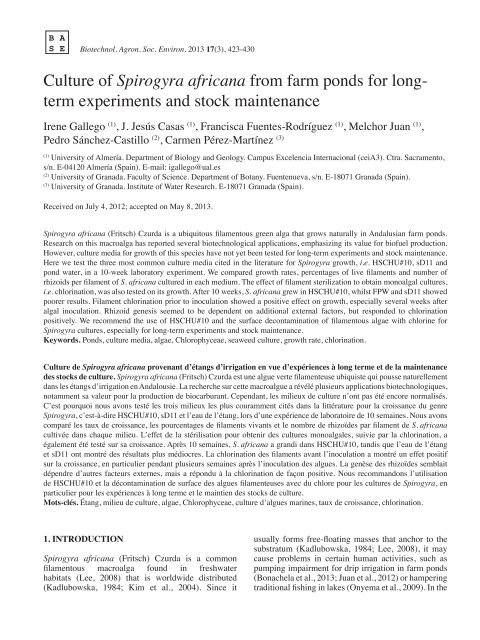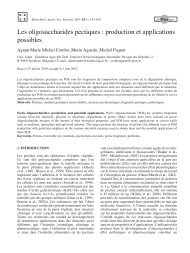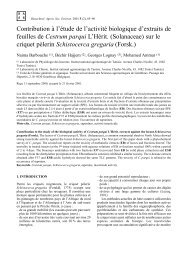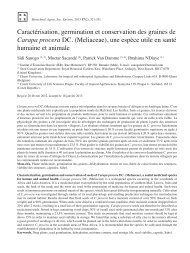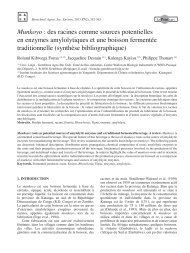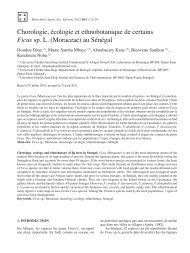Culture of Spirogyra africana from farm ponds for long- term ...
Culture of Spirogyra africana from farm ponds for long- term ...
Culture of Spirogyra africana from farm ponds for long- term ...
Create successful ePaper yourself
Turn your PDF publications into a flip-book with our unique Google optimized e-Paper software.
424 Biotechnol. Agron. Soc. Environ. 2013 17(3), 423-430 Gallego I., Casas J.J., Fuentes-Rodriguez F. et al.case <strong>of</strong> Andalusian <strong>farm</strong> <strong>ponds</strong>, S. <strong>africana</strong> is one <strong>of</strong> themost common growing macroalgae, which may <strong>for</strong>msmonoalgal mats during spring months (I. Gallego,unpubl. data).The genus <strong>Spirogyra</strong> has recently drawn attentionto researchers due to its various biotechnological andindustrial applications, mostly based on its sorptionproperties. <strong>Spirogyra</strong> filaments remove heavy metals(Romera et al., 2007; Singh et al., 2007; Kaonga et al.,2008; Pribyl et al., 2008) and other toxic compounds<strong>from</strong> effluents (Aleissa et al., 2004; Çelekli et al.,2009); as well as they produce allelochemicalsinhibiting microalgal growth (Zakaria, 2002; Trochineet al., 2011), implying important consequences <strong>for</strong>the management <strong>of</strong> aquatic ecosystems. Antiviraland antihelmintic properties have also been reported(Muller-Feuga et al., 2003; Pultz et al., 2004). Morerecently, <strong>Spirogyra</strong> biomass has been shown to bean efficient energy source <strong>for</strong> bi<strong>of</strong>uel (Hossain et al.,2008; Eshaq et al., 2010; John et al., 2011).Both stock maintenance and growth <strong>of</strong> algal speciesare essential <strong>for</strong> their use in biotechnology. There<strong>for</strong>e,the search <strong>of</strong> the most suitable culture media and ease<strong>of</strong> laboratory culture are relevant topics. Regardinggenus <strong>Spirogyra</strong>, culture techniques were firstreported early in the 20 th century (see Kadlubowska,1984 and references herein). Mainly three culturemedia have proved successful <strong>for</strong> <strong>Spirogyra</strong> growthunder laboratory conditions in short-<strong>term</strong> culture:sD11 (Graham et al., 1995), Half-Strength CHU#10(Nalewajko et al., 1989), and Artificial Pond Water(Inoue et al., 2002). However, their suitability <strong>for</strong> <strong>long</strong><strong>term</strong>experiments has not been tested so far, neithercontrasting experiments on different culturing mediahave not been carried out under the same environmentalconditions (e.g. irradiance, temperature).One <strong>of</strong> the most widely used media <strong>for</strong> <strong>Spirogyra</strong>cultures nowadays is water <strong>from</strong> the source ecosystem,e.g. Townsend et al. (2008), sometimes replaced byArtificial Pond Water (Inoue et al., 2002; Ikegaya et al.,2004; Yoshida et al., 2009). sD11 culture medium hasalso proved suitable <strong>for</strong> <strong>Spirogyra</strong> culturing (Nalewajkoet al., 1989). It is derived <strong>from</strong> D11 medium, originallyused <strong>for</strong> Cladophora Kützing (1843) and slightlymodified <strong>for</strong> <strong>Spirogyra</strong> (Graham et al., 1995; O’Nealet al., 1995). Half-Strength CHU#10, hence<strong>for</strong>thHSCHU#10, has been widely used <strong>for</strong> a variety <strong>of</strong>green alga, including <strong>Spirogyra</strong> spp. (Saygideger,1996).The presence <strong>of</strong> epibionts in <strong>Spirogyra</strong> in vitrocultures is one <strong>of</strong> the major problems in testing filamentsgrowth, despite the continuous mucilage secretion <strong>from</strong><strong>Spirogyra</strong> cell walls (Simons et al., 1990; Wöber et al.,2007). Among the several techniques used to removeepibionts <strong>from</strong> macroalgae, chlorination – an oxidantsterilization <strong>of</strong> filaments with a sodium hypochloritesolution – has been successful <strong>for</strong> epiphytic algae inseawater (Pang et al., 2007) and is commonly used <strong>for</strong>obtaining axenic cultures, e.g. García-Jiménez et al.(1999). To our knowledge, no evidence has been found<strong>for</strong> its use in <strong>Spirogyra</strong> cultures.Rhizoid production has also been included as aparameter <strong>for</strong> quantifying filament growth and survival,since rhizoids fix the filaments to the substratum andhence facilitate algal survival. Several factors havebeen reported as drivers <strong>of</strong> rhizoid genesis, such assubstratum properties (Ikegaya et al., 2008) or thelowering <strong>of</strong> extracellular Ca 2+ concentration (Inoueet al., 2002; Yamada et al., 2003). Release <strong>of</strong> singlecells resulting <strong>from</strong> filament-severing (Inoue et al.,2002; Ikegaya et al., 2008) has also been reported as atriggering factor.In the present study, we measured growth rate,percentage <strong>of</strong> live filaments and rhizoid production <strong>of</strong><strong>Spirogyra</strong> <strong>africana</strong> filaments over 10 weeks in threecommonly-used culture media – sD11, HSCHU#10and Filtered Pond Water (FPW) i.e. water <strong>from</strong> thesource pond where the filaments were gathered – withthe aim <strong>of</strong> culturing <strong>Spirogyra</strong> <strong>africana</strong> <strong>for</strong> <strong>long</strong><strong>term</strong>maintenance, thus facilitating biotechnologicalapplications and stock maintenance. Additionally, wetested the effect <strong>of</strong> sterilization with NaClO (hence<strong>for</strong>thchlorination) as a procedure <strong>for</strong> assuring monoalgalcultures.2. MATERIALS AND METHODS2.1. Sample collection and laboratory analysesFilaments were collected <strong>from</strong> a small agriculturalpond measuring 20 x 18 x 1.75 m (L x W x D), locatedin Almería, SE Spain. As the filaments were anchoredonto the substratum, a rake was used to collect them.Samples were rinsed in pond water to remove sedimentand immediately taken to the laboratory. For thepreparation and chemical analysis <strong>of</strong> FPW, 10 l waterwere taken with a centrifugal electric pump <strong>from</strong> thebottom <strong>of</strong> the pond, where <strong>Spirogyra</strong> filaments weregrowing.2.2. Laboratory experimentThe influence <strong>of</strong> culture media type and chlorinationon <strong>Spirogyra</strong> <strong>africana</strong> growth and rhizoid productionwere investigated in a laboratory experiment with a3 x 2 factorial design, with culture media and filamentchlorination as independent factors. Four replicates pertreatment were per<strong>for</strong>med, with a total <strong>of</strong> 24 cultureflasks.Three different culture media were analyzed: sD11,HSCHU#10 and FPW (pond water filtered through a
426 Biotechnol. Agron. Soc. Environ. 2013 17(3), 423-430 Gallego I., Casas J.J., Fuentes-Rodriguez F. et al.and number <strong>of</strong> rhizoids per filament. When ANOVAsshowed significant differences between groups (culturemedia, chlorination conditions), Tukey’s HSD posthoctests were used. All analyses were per<strong>for</strong>med withSTATISTICA 7.1 s<strong>of</strong>tware (Stats<strong>of</strong>t Inc., 2005).a0.040.02b3. RESULTS3.1. Effect <strong>of</strong> culture media on S. <strong>africana</strong> growthrateThe three culture media showed substantial differencesin nutrient composition (Table 1). HSCHU#10 andsD11 contained N:P molar ratios that varied <strong>from</strong> aP-impoverished FPW medium to a N-depleted ratioin sD11, whereas HSCHU#10 showed an N:P rationearest to the optimal Redfield ratio <strong>for</strong> phytoplankton,namely 16:1.At the end <strong>of</strong> the experiment, S. <strong>africana</strong> onlyshowed a positive growth rate in HSCHU#10(Figure 1). All replicates in sD11 and FPW showednegative growth rates. The two-factor ANOVA testshowed significant differences in S. <strong>africana</strong> growthrate between culture media (F = 429.784; P < 0.001),between chlorination treatments (F = 152.025;P < 0.001) and in the interaction <strong>of</strong> both factors(F = 53.315; P < 0.001).Table 1. Nutrient concentration (mg.l -1 ), N:P molar ratioand pH <strong>of</strong> the three culture media tested to de<strong>term</strong>ineits effect on growth, filament survival and rhizoiddevelopment <strong>of</strong> <strong>Spirogyra</strong> <strong>africana</strong> — Concentration deséléments nutritifs (mg.l -1 ), rapport molaire N:P et ph destrois milieux de culture testés pour dé<strong>term</strong>iner son effet surla croissance, la survie des filaments et le développementdes rhizomes de <strong>Spirogyra</strong> <strong>africana</strong>.ParameterMediumHSCHU#10 sD11 FPWCa 2+ 4.89 16.98 221.52Mg 2+ 1.23 9.86 130.07Fe 3+ 0.14 1.00 n.m.K + 0.56 41.54 30.02Na + 4.52 13.84 330.55Cl - 0.09 7.13 472.75NO 3- 7.56 26.26 1.27PO 43-1.36 81.78 0.001HCO 3-+ CO 32-5.66 21.43 48.3N:P molar 8.5:1 1:2 1088:1pH 7.3 7.1 8.4n.m. = not measured value — valeur non mesurée.Growth rate (d -1 )0.00-0.02-0.04-0.06-0.08HSCHU#10sD11FPWHSCHU#10sD11FPWFigure 1. Growth rate (expressed as d -1 ) <strong>of</strong> <strong>Spirogyra</strong><strong>africana</strong> in three culture media tested, in non-chlorinated(a) and chlorinated samples (b) — Taux de croissance (parjour) de <strong>Spirogyra</strong> <strong>africana</strong> dans trois milieux de culturetestés, dans des échantillons non chlorés (a) et chlorés (b).Bars denote standard error — Les barres indiquent l’erreurstandard; *** P < 0.001: two-way ANOVA — ANOVA à deuxfacteurs.3.2. Effect <strong>of</strong> culture media on live filamentsThe type <strong>of</strong> culture media also affected the percentage<strong>of</strong> live filaments (ANOVA F = 150.093; P < 0.001),with HSCHU#10 proving to be the highest and FPWthe lowest (Figure 2). Furthermore, the effect <strong>of</strong> culturemedia and time was significant (ANOVA F = 53.452;P < 0.001), since HSCHU#10 showed asymptoticvalues around 90% <strong>of</strong> the initial value after 10 weeksand both sD11 and FPW showed percentages close to40% at the end <strong>of</strong> the experiment. Chlorination hadno effect on the percentage <strong>of</strong> live filaments (ANOVAF = 2.665; P > 0.05) but the interaction <strong>of</strong> time andchlorination showed a positive effect (ANOVAF = 19.019; P < 0.001).3.3. Effect <strong>of</strong> culture media on rhizoid productionRhizoid genesis was observed <strong>from</strong> the first week afterinoculation (Figure 3). The percentage <strong>of</strong> rhizoids perlive filament was affected by the type <strong>of</strong> culture mediaused (ANOVA F = 4.044; P < 0.05). Tukey’s HSDpost hoc test showed that sD11 was the medium with
<strong>Culture</strong> <strong>of</strong> <strong>Spirogyra</strong> <strong>africana</strong> 427a100HSCHU#10 sD11 FPWb100Life filaments (%)80604020Life filaments (%)8060402000 1 2 3 4 5 6 7 8 9 10Weeks after the inoculation00 1 2 3 4 5 6 7 8 9 10Weeks after the inoculationFigure 2. Percentage <strong>of</strong> live filaments <strong>of</strong> <strong>Spirogyra</strong> <strong>africana</strong> in HSCHU#10, sD11 and FPW culture media, in non-chlorinated(a) and chlorinated samples(b) during 10 weeks — Pourcentage de filaments vivants de <strong>Spirogyra</strong> <strong>africana</strong> dans les milieux deculture HSCHU#10, sD11 et FPW, dans des échantillons non chlorés (a) et chlorés (b) durant 10 semaines.Mean values <strong>of</strong> the four replicates are shown — Les valeurs moyennes des quatre répétitions sont indiquées; Bars indicate standarderror — Les barres indiquent l’erreur standard.HSCHU#10 sD11 FPWa1b1Rhizoids per filament0.80.60.40.2Rhizoids per filament0.80.60.40.200 1 2 3 4 5 6 7 8 9 10Weeks after the inoculation00 1 2 3 4 5 6 7 8 9 10Weeks after the inoculationFigure 3. Evolution <strong>of</strong> rhizoid production (number <strong>of</strong> rhizoids per filament) in HSCHU#10, sD11, FPW, in non-chlorinated(a) and chlorinated samples (b) during 10 weeks — Évolution de la production de rhizoïdes (nombre de rhizoïdes par filament)dans HSCHU#10, sD11, FPW, dans des échantillons non chlorés (a) et chlorés (b) pendant 10 semaines.Mean values <strong>of</strong> the four replicates are shown — Les valeurs moyennes des quatre répétitions sont indiquées; Bars indicate standarderror — Les barres indiquent l’erreur standard.the lowest number <strong>of</strong> rhizoids per filament (P < 0.05),whereas both HSCHU#10 and FPW showed nosignificant differences (P > 0.05). Chlorinationincreased rhizoid production (ANOVA F = 23.956;P < 0.001). However, the interaction <strong>of</strong> medium andchlorination was not statistically significant (F = 1.731;P > 0.05).4. DISCUSSION4.1. Suitability <strong>of</strong> the culture mediaOur results show that HSCHU#10 is the mostsuitable <strong>of</strong> the three assayed media <strong>for</strong> S. <strong>africana</strong>culture, since both growth rate and percentage <strong>of</strong> live
428 Biotechnol. Agron. Soc. Environ. 2013 17(3), 423-430 Gallego I., Casas J.J., Fuentes-Rodriguez F. et al.filaments were higher in this medium compared to theothers. This can be explained by the difference in thenutrient composition <strong>of</strong> the three culture media tested,particularly their contrasting N:P molar ratios, sinceboth are essential macronutrients <strong>for</strong> algal primaryproduction (Sterner et al., 2002; Klausmeier et al.,2004). In the field, a high growth <strong>of</strong> the <strong>Spirogyra</strong>fluviatilis Hilse complex was reported after fertilizingwith a molar ratio N:P = 10:1 (Townsend et al., 2008).This approaches the HSCHU#10 <strong>of</strong> our experiments(N:P = 8.5:1) and both are relatively close to the optimalRedfield ratio <strong>of</strong> 16:1 proposed <strong>for</strong> phytoplankton(Klausmeier et al., 2004). However, the N:P supplyratios <strong>of</strong> FPW and sD11 significantly deviated <strong>from</strong>the ratio both Redfield ratio and the ratio proposed byTownsend et al. (2008), pointing respectively to a case<strong>of</strong> P- and N- impoverished media.<strong>Spirogyra</strong> <strong>africana</strong> mats grew in the pond withapparently no nutrient limitations during the 10 weeks<strong>of</strong> our experiment (I. Gallego, unpubl. data) while FPWshowed the poorest result. It is likely that the sedimentwas an important P source <strong>for</strong> this benthic alga in thenatural system (Townsend et al., 2008). The extremelylow-P FPW probably resulted in a severe nutrientdepletion in our experiment, where the pond sedimentwas not included.Contrary to our expectations, S. <strong>africana</strong> filamentsdid not grow in sD11 and the percentage <strong>of</strong> livefilaments was relatively low. The specific sD11 mediumhas been reported as a successful medium to grow<strong>Spirogyra</strong> spp. in vitro cultures (Graham et al., 1995;O’Neal et al., 1995; Berry et al., 2000). However, weobtained poorer results with this medium comparedto HSCHU#10, a medium commonly used on a widerange <strong>of</strong> algae (Saygideger, 1996). Our experimentalconditions were similar to those used previously with<strong>Spirogyra</strong> spp. growing in sD11, i.e. temperature,irradiance and a weekly medium replacement.However, our experiment lasted <strong>for</strong> 10 weeks and halfthe medium was replaced weekly, whilst previous oneslasted only <strong>for</strong> 2-3 weeks (O’Neal et al., 1995; Berryet al., 2000) and media were entirely replenished every7-10 days (Berry et al., 2000). The effect <strong>of</strong> N depletionon S. <strong>africana</strong> growth became evident several weeksafter inoculation in sD11, while filaments in short-<strong>term</strong>cultures could thrive <strong>for</strong> a while on cellular N reserves.Our results show that despite the reportedly goodresults <strong>of</strong> the specific sD11 medium <strong>for</strong> S. <strong>africana</strong>cultures, filament growth <strong>for</strong> <strong>long</strong>-<strong>term</strong> cultures is notguaranteed.Indeed, mat cohesiveness was studied by Berryet al. (2000) as an indicator <strong>of</strong> filament decline thatdepends on irradiance. A higher filament entanglementwas observed in our sD11 replicates than in FPW andHSCHU#10 (data not shown), despite all our replicateswere exposed to the same irradiation. We suggest thatcohesiveness may be also dependent on the mediumnutrient content as well, although further study isrequired in this area.Since there is a lack <strong>of</strong> studies on irradiance and/or temperature using other culture media apart <strong>from</strong>sD11, we can only suggest that the observed matcohesiveness and the low-N composition <strong>of</strong> sD11 maybe detrimental <strong>for</strong> S. <strong>africana</strong> survival.The conditions <strong>for</strong> avoiding nutrient depletionin our experiment (weekly replacement <strong>of</strong> half themedium) were clearly insufficient in sD11 and FPW,but seemed to be adequate in HSCHU#10. Indeed, theeffect <strong>of</strong> mat cohesiveness may interact with nutrientcomposition and nutrient depletion. Thus, <strong>long</strong>-<strong>term</strong>cultures can be per<strong>for</strong>med in HSCHU#10 with lesslaboratory manipulation and ef<strong>for</strong>t, so we recommendthis medium <strong>for</strong> <strong>long</strong>-<strong>term</strong> experiments or <strong>for</strong> themaintenance <strong>of</strong> stock cultures <strong>of</strong> S. <strong>africana</strong>.Effectiveness <strong>of</strong> chlorination on S. <strong>africana</strong> growth.Chlorination had a positive effect on filaments growth,while the effect <strong>of</strong> chlorination on the percentage <strong>of</strong>live filaments was only significant when interacted withtime. Chlorine is reported as a traditional sterilizingagent <strong>for</strong> removing epibionts <strong>from</strong> macroalgae(García-Jiménez et al., 1999; Pang et al., 2007) and freechlorine also inactivates bacteria and cyanoprokariota(Daly et al., 2007; Amiri et al., 2010). The elimination<strong>of</strong> these nutrient competitors by chlorination probablyfavored <strong>Spirogyra</strong> growth. In spite <strong>of</strong> this apparentlypositive effect, sodium hypochlorite can react withpolysaccharides present in the mucilaginous sheath<strong>of</strong> the Zygnemataceae (Cheli et al., 1989) and evendamage the cell walls. Thus, the higher mortalityobserved in chlorinated samples at the beginning <strong>of</strong>the experiment could be attributed to this treatment.However, at the end <strong>of</strong> the experiment, this likelydamage might be counteracted by the elimination <strong>of</strong>competitors.4.2. Rhizoid genesis in S. <strong>africana</strong>Our results on rhizoid production are not as clear asthose on growth and percentage <strong>of</strong> live filaments.The N:P ratio does not seem to be involved in rhizoidproduction, since both HSCHU#10 and FPW showedsimilar results. A low extracellular Ca 2+ concentrationand release <strong>of</strong> single cells have also been reported astriggering factors <strong>of</strong> rhizoid <strong>for</strong>mation (Nalewajkoet al., 1989; Ikegaya et al., 2004). Nonetheless, thelowest concentration <strong>of</strong> Ca 2+ occurred in HSCHU#10,which showed high rhizoid <strong>for</strong>mation, while singlecells released <strong>from</strong> filaments were observed in bothsD11 and FPW (I. Gallego, unpubl. data), whichparadoxically showed different results. We suggestthat other unidentified factors, not described in the
<strong>Culture</strong> <strong>of</strong> <strong>Spirogyra</strong> <strong>africana</strong> 429literature so far, may be involved in the process <strong>of</strong>rhizoid genesis. However, chlorination increasedrhizoid genesis, supporting our previous results on thepositive effect <strong>of</strong> chlorine sterilization on <strong>Spirogyra</strong>filaments.5. CONCLUSIONThe search <strong>of</strong> the most suitable culture media <strong>for</strong>stock maintenance and optimal growth <strong>of</strong> S. <strong>africana</strong>is essential <strong>for</strong> its subsequent use in biotechnology.For this purpose, we tested the suitability <strong>of</strong> the threeculture media most commonly used <strong>for</strong> S. <strong>africana</strong>growth.Half-Strength CHU#10 was the most suitable <strong>of</strong> themedia assayed <strong>for</strong> S. <strong>africana</strong> growth and it seems tobe appropriate <strong>for</strong> <strong>long</strong>-<strong>term</strong> experiments. The widelyused sD11 specifically modified <strong>for</strong> <strong>Spirogyra</strong> showedpoorer results.Filament chlorination prior to experimentinoculation showed a positive effect on S. <strong>africana</strong>growth and rhizoid production.We recommend the use <strong>of</strong> both Half-StrengthCHU#10 and surface decontamination <strong>of</strong> filamentousalgae with NaClO <strong>for</strong> <strong>Spirogyra</strong> cultures. Thus, <strong>long</strong>er<strong>term</strong>cultures can be per<strong>for</strong>med with less laboratorymanipulation and ef<strong>for</strong>t.AbbreviationsHSCHU#10: Half-Strength CHU#10FPW: Filtered Pond WaterAcknowledgementsThis research has been funded by the Andalusian RegionalGovernment (Junta de Andalucía, Consejería de MedioAmbiente y Consejería de Innovación, Ciencia y Empleo)as part <strong>of</strong> the project P06-RNM01709. We thank the pondowner <strong>for</strong> allowing us access and sampling. We sincerelythank Enric Descals <strong>for</strong> editorial assistance.BibliographyAleissa K.A., Shabana E.S.I. & Al-Masoud F.I.S., 2004.Accumulation <strong>of</strong> uranium by filamentous green algaeunder natural environmental conditions. J. Radioanal.Nucl. Chem., 260, 683-687.Amiri F., Mesquita M.M.F. & Andrews S.A., 2010.Disinfection effectiveness <strong>of</strong> organic chloramines,investigating the effect <strong>of</strong> pH. Water Res., 44, 845-853.APHA, 2005. Standard methods <strong>for</strong> the examination <strong>of</strong> thewater and wastewater. 22 th ed. Washington, DC: APHA.Berry H.A. & Lembi C., 2000. Effects <strong>of</strong> temperatureand irradiance on the seasonal variation <strong>of</strong> <strong>Spirogyra</strong>(Chlorophyta) population in a Midwestern lake (USA).J. Phycol., 36, 841-851.Bonachela S. et al., 2013. Pond management and waterquality <strong>for</strong> drip irrigation in Mediterranean intensivehorticultural systems. Irrig. Sci., 31, 769-780.Casas J.J. et al., 2011. Artificial <strong>ponds</strong> in a Mediterraneanregion (Andalusia, southern Spain): agricultural andenvironmental issues. Water Environ. J., 25, 308-317.Çelekli A., Yavuzatmaca M. & Bozkurt H., 2009. Kineticand equilibrium studies on the adsorption <strong>of</strong> reactivered 120 <strong>from</strong> aqueous solution on <strong>Spirogyra</strong> majuscula.Chem. Eng. J., 152, 139-145.Cheli F. & De Vecchi L., 1989. An ultrastructural andcytochemical study on Conjugatophycean cell wall.Caryologia, 42, 127-137.Daly R.I., Ho L. & Brookes J.D., 2007. Effect <strong>of</strong> chlorinationon Microcystis aeruginosa cell integrity and subsequentmicrocystin release and degradation. Environ. Sci.Technol., 41, 4447-4453.Eshaq F.S., Ali M.N. & Mohd M.K., 2010. <strong>Spirogyra</strong>biomass a renewable source <strong>for</strong> bi<strong>of</strong>uel (bioethanol)production. Int. J. Environ. Sci. Technol., 2, 7045-7054.García-Jiménez P., Marian F.D., Rodrigo M. &Robaina R.R., 1999. Sporulation and sterilizationmethod <strong>for</strong> axenic culture <strong>of</strong> Gelidium canariensis.J. Biotechnol., 70, 227-229.Graham J.M., Lembi C.A., Adrian H.L. & Spencer D.F.,1995. Physiological responses to temperature andirradiance in <strong>Spirogyra</strong> (Zygnematales, Charophyceae).J. Phycol., 31, 531-540.Hossain A.B.M.S. et al., 2008. Biodiesel fuel production<strong>from</strong> algae as renewable energy. Am. J. Biochem.Biotechnol., 4, 250-254.Ikegaya H., Yamada S.Y., Sonobe S. & Shimmen T., 2004.Saponin-induced release <strong>of</strong> single cells <strong>from</strong> filamentsand rhizoid differentiation in <strong>Spirogyra</strong>. J. Plant Res.,117, 443-447.Ikegaya H. et al., 2008. Presence <strong>of</strong> xyloglucan-likepolysaccharide in <strong>Spirogyra</strong> and possible involvementin cell-cell attachment. Phycol. Res., 56, 216-222.Inoue N., Yamada S., Nagata Y. & Shimmen T., 2002.Rhizoid differentiation in <strong>Spirogyra</strong>: position sensing by<strong>term</strong>inal cells. Plant Cell Physiol., 43, 479-483.Iwata K., Tazawa M. & Itoh T., 2001. Turgor pressureregulation and the orientation <strong>of</strong> cortical microtubules in<strong>Spirogyra</strong> cells. Plant Cell Physiol., 42, 594-598.John R.P., Anisha G.S., Nampoothiri K.M. & Pandey A.,2011. Micro and macroalgal biomass: a renewable source<strong>for</strong> bioethanol. Bioresour. Technol., 102, 186-193.Juan M. et al., 2012. Construction characteristics andmanagement practices <strong>of</strong> in-<strong>farm</strong> irrigation <strong>ponds</strong>in intensive agricultural systems. Agronomic andenvironmental implications. Irrig. Drain., 61(5), 657-665.Kadlubowska J.Z., 1984. Süsswasserflora von Mitteleuropa.Band 16, Chlorophyta VIII. Conjugatophyceae I:


